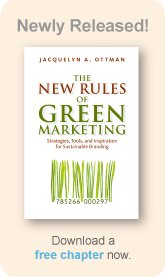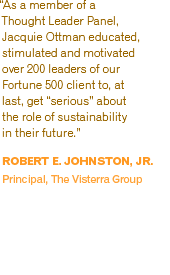How Nike Reduces Toxicity to Balance Consumer Needs with Enhanced Corporate Reputation
By Jacquie Ottman
Sustainable Brands Weekly, February 2010
Phthalates, BPA, mercury and PVC aren't the only toxics associated with everyday consumer products. Chemical agents in common cleaning products thought to pose a significant risk to children and pets is fueling a robust market for greener cleaners made from plants such as GreenWorks and Method. And concerns over pesticides on foods has caused a steady run up in sales of organics for the past twenty years. Heeding consumer demand for healthier products, the U.S. Congress passed the Consumer Product Safety Improvement Act in August 2008 banning phthalates in children's toys. Retailers such as Wal-Mart, Target, and Toys R Us began requiring suppliers to follow similar standards for all children's products by January 2009.
Reducing toxicity is good for business. It can reduce the liability associated with risks to workers, and via alternatives that are safer to handle, can enhance productivity and cut workers' compensation claims. Less (or non) toxic materials save money on handling costs, while speeding time to market since there may be fewer legal hurdles to navigate. And of course, there's the opportunity to market to the growing number of mainstream consumers looking for safer alternatives.
Such risks and opportunities are not lost on Nike. They are working hard to reduce toxicity by incorporating the principles of its Considered line which eliminated most adhesives to join uppers and lowers into many other products, such as Air Jordan XX3. The new Air Jordan XX3 is constructed using material from old recycled sneakers, manufacturing scraps, and jigsaw-like components for the inner construction that uses less glue. This shoe even inspired the invention of a sewing machine designed to produce sneakers using more stitching and fewer chemical-based glues.
However, rather than underscoring its green attributes, the Air Jordan XX3 is targeted toward the same audience as the rest of the Air Jordan line, with the emphasis placed on performance. The green factor is included as an added bonus for those who are interested. Consumers are buying: Nike brand chief Charles Denson reports that during the first quarter of 2009, the company's basketball shoe division grew by double digits, propelled by Air Jordan sales.
Is Nike losing out on a good green marketing opportunity by opting out of boasting about its environmental achievement to consumers? Not a chance. Nike knows that its largely urban young male audience is primarily interested in performance, not the details of how a product is made. However, communications targeted to employees, investors and other important stakeholders do discuss reduced toxicity, and as such enhance the Nike brand and corporate reputation -a slam dunk of an approach for sure.



 ShareThis
ShareThis
Jacquelyn Ottman is president, J. Ottman Consulting,
a green marketing consultancy that advises businesses on strategies for
developing and marketing environmentally sustainable products and
services. She is the author of three books on green marketing. Her
latest book,The New Rules of Green Marketing, is due out
in 2010.
Contact her by email
Follow her on Twitter
Connect to
her onLinkedin
Read
her blog
Note: This article was first published in Sustainable Brands Weekly. Jacquie Ottman is president of J. Ottman Consulting. This post is excerpted from Jacquie Ottman's soon-to-be- published book on doing green marketing right. Learn more and sign up to be notified of its release by clicking here.


